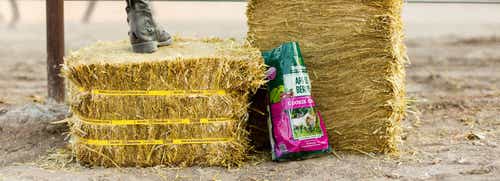
Must-Know Proper Forage Storage Tips
Forage is the foundation of your horse’s diet, meaning that you need to be able to safely store large volumes of it throughout the year. As this year’s forage is harvested, you’re likely filling your barn with bales in order to stock up. But proper storage methods are important, since they can help to keep the forage in good, feedable condition, and may even play a role in reducing the risk of a barn fire.
Forage Storage Location
Where you store your forage is an important choice that can affect the safety of your barn and animals. If possible, it’s best to store forage – especially when it’s been newly baled– in a building that is separated from your barn.

Evaluating Your Forage
Before you bring in a new load of bales, you’ll need to make sure that the forage has been properly baled and is safe to put into your barn. Bringing in forage that was baled with high moisture levels can make for a fire hazard. The centers of the bales can heat up and even combust over time. The same is true of storing forage that is moldy.
To inspect your forage, break open a few bales and inspect the centers. Look for signs of mold and smell the forage – it should smell sweet and shouldn’t be overly dusty. You can use a candy thermometer, or any thermometer that reads up to 200 degrees Fahrenheit, to check the temperature of the bales. Temperatures ranging from 121 to 140 degrees Fahrenheit are concerning and should be monitored. Temperatures from 141 to 160 degrees Fahrenheit should be checked every day, and can lead to dangerous conditions. Temperatures of 175 degrees Fahrenheit and up mean that your forage can combust and you must contact your fire department.

Forage Storage Methods
When it comes to storing bales, the most popular method is to place the bales on wood pallets. These pallets allow air to circulate beneath the bales, which is beneficial when the forage is newly harvested. Additionally, this helps to keep the bales up and off of the ground. If your bales come into contact with the ground, they can absorb moisture (especially during temperature fluctuations) and will quickly mold.
As you stack your bales, you’ll also want to create the stack to maximize ventilation. One popular way to do this is to alternate the orientation of the bales in each layer. Make your first layer with the hay strings facing upward, then for the next layer, turn the bales on their sides so the strings face outward.
When Forage Storage Is Limited
If you have limited storage space for forage, or come into a shortage where you can’t get enough bales, remember that Standlee Premium Western Forage® offers a wide variety options to substitute or supplement the diet of your animal. Quality products like Standlee timothy grass pellets, alfalfa cubes, beet pulp pellets, and our alfalfa/orchard compressed bales, available nationwide, will ensure that you’re able to keep your horses fed year-round.








